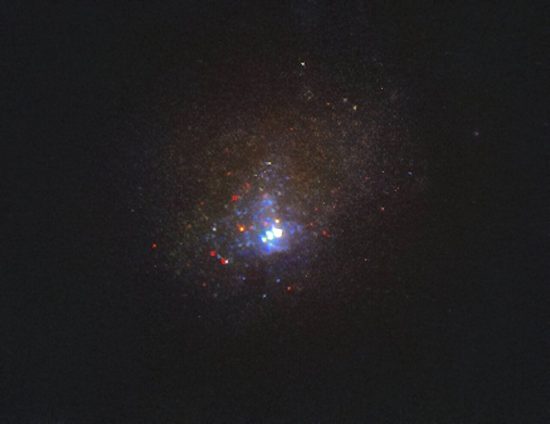
July 1, 2020
According to a recent press release, astronomers from the European Southern Observatory (ESO) cannot find “..an unstable massive star in a dwarf galaxy.”
Several explanations are presented. Among them are, the star is now obscured by dust; or, it could have collapsed into a black hole without a prior supernova event. The star was located in the Kinman Dwarf galaxy, some 75 million light-years away in the constellation of Aquarius. Since the dwarf galaxy is so far away, there is no way to detect individual stars, but radiation from large, bright individual stars can be seen amidst the haze. One such blue giant star was seen in 2001, but was absent from observations in 2019.
Stars are conventionally thought to live their lives based on a well-established process. Internal hydrogen fusion reactions are thought to create ever heavier elements, until the nuclear fuel is exhausted through radiative output. The star will then implode, throwing off its outer layers. Therefore, a star’s age is theoretically determined by its temperature and luminosity.
Previous Pictures of the Day argue against accretion and gravity-only models of compaction; thermonuclear furnaces in stellar cores; age-relevant data compiled from stellar brightness and color; and gravitational acceleration by congregations of loose-knit spiral arms. All such conventional ideas about galactic evolution are contradicted by an electric explanation.
It is plain that astronomers are not mapping the electric charge flowing through space in order to determine its influence on stellar evolution. Because of that oversight, they constantly overstate the gravitational model of the cosmos.
Retired Professor of Electrical engineering Dr. Donald Scott wrote that the absolute brightness of a star depends on the strength of the current density impinging into its surface, along with the star’s diameter. As current density increases, a star becomes hotter and brighter, glowing bluer and whiter. If the current flow into the star decreases, a star becomes red and cools down. So using magnitude and color to determine a star’s age is a false premise.
Variations in stellar chemistry, as well as their velocity differences, are explained by a plasma hypothesis. It is the electrical forces active in space and not the gravitational shuffling of locations that causes differences among the stars. If those electrical forces are withdrawn, a star will suddenly lose its fierce discharge and wink-out like a dying spark.
Stephen Smith
The Thunderbolts Picture of the Day is generously supported by the Mainwaring Archive Foundation.












